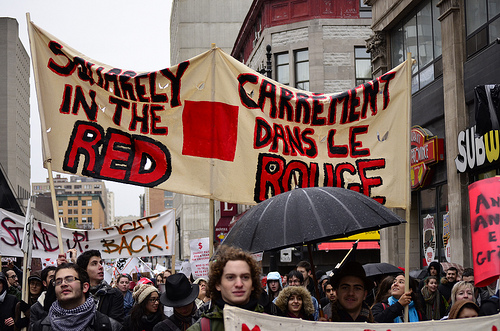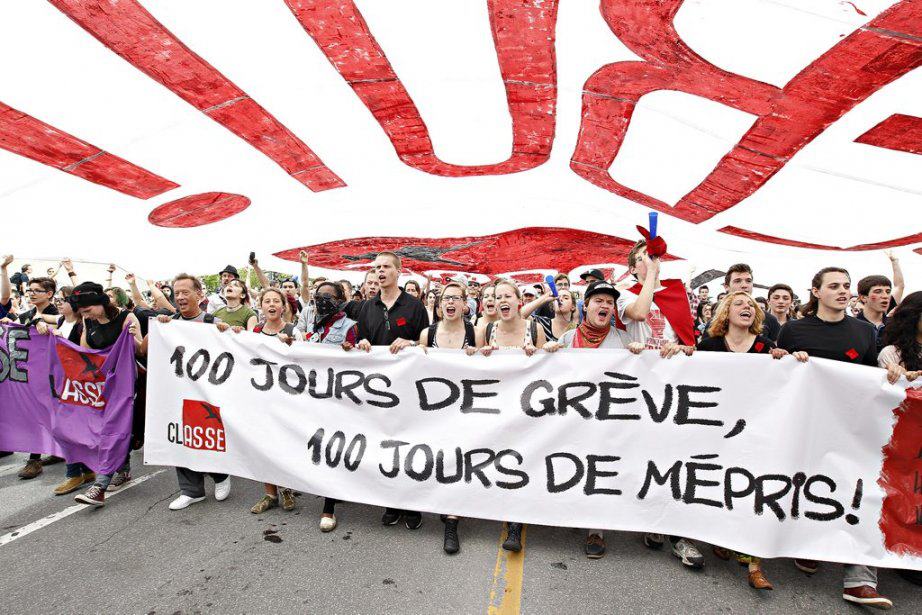by Xavier LaFrance and Alan Sears
May 25, 2012

Photo: Photomaxmtl
The Charest government has turned to repression to try to break the largest and longest student strike in Quebec history. Students had already endured heavy-handed policing, including hundreds of arrests and brutal attacks by riot cops on campuses and in the streets. The new strikebreaking legislation, Bill 78, is a brutal clampdown on the right to organize collectively and on freedom of expression. The protest plans for any demonstrations of more than 50 people must be cleared with the police in advance of any gathering, or the action will be considered illegal. Individual students, staff or faculty members who advocate the ongoing strike action risk harsh penalties, and student unions or university employees unions who organize or support ongoing strike activity will face heavy fines.
After more than three months, over 170,000 CEGEP (collège d’enseignement général et professionnel) and university students are still on strike against tuition increases and for free education. At its height, the movement mobilized over 300,000 in strike action, some for a few days and others with an unlimited mandate. Over 200,000 joined the massive demonstration on March 22. The strike was triggered by the Charest government’s plan to boost tuition fees by 75% over the next five years, which the government later changed to an 80% increase over 7 years in a so-called “offer” to students. The tuition hike is important as it normalizes the principle of user pay post-secondary education, and thus forms part of the “cultural revolution” promised by Quebec Finance Minister Raymond Bachand to destroy the idea of public services as a social right. The introduction of a flat tax of $200,00 for health services is part of the same agenda.
The strike movement has shown remarkable tenacity despite attempts by the government to drive students back to class through repression, including brutal policing, threats of losing the school year and the heavy use of injunctions to limit the right to protest on campuses. The Charest government has tried to break up the common front of student organizations, offering to negotiate with some groups while excluding others. But this has not worked.
Under pressure from a strike they could not break, the government did offer to spread the tuition increase over seven years, although at the same time bumping up the overall hike. They finally sat at a negotiating table with representatives from the student unions, along with trade union leaders and campus administrations. The resulting “offer” by the government basically committed to passing along some potential cost savings identified by a joint student-administration-government commission to students in the form of tuition reductions. The student unions asked members to vote on this, and it was overwhelmingly rejected. Education Minister Line Beauchamp then resigned, and the government shifted towards the brutal strikebreaking strategy of Bill 78.
The Quebec strike is part of a pattern of anti-austerity activism that has included the massive Chilean student mobilization and militant student movements in Britain and California, as well as uprisings in North Africa and the Middle East, the Occupy movement, and anti-austerity strikes in Wisconsin and Southern Europe. There will likely be more protests, as students have every reason to be angry at tuition increases, the declining quality of education and grim job prospects upon graduation. Governments and employers are clear-cutting good jobs, slashing social programs and attacking migrant rights in the name of austerity, leaving post-secondary graduates facing debt and precariousness after an impersonal and often unsatisfactory education.
A poll published in the Globe and Mail on May 7 showed that 62% of students across Canada said they would strike against tuition increases, including over 69% in Ontario. The major obstacle to an upsurge in student activism elsewhere is not a lack of anger, but rather a lack of confidence in the idea that it is possible to fight the austerity agenda of tuition increases and major changes to education. The Quebec student movement has developed sophisticated political perspectives through a long history of mobilization that can contribute to rebuilding the confidence and capacity to fight elsewhere. There is much to learn from the model of democratic, activist student unionism that has played such an important role in galvanizing sustained militancy in Quebec.

Photo: Kunal Shah
Red Square
Active solidarity with the Quebec strike movement in the face of the Charest clampdown is crucial for student and workers struggles against austerity, as the Quebec government is targeting the right to organize collectively. This means spreading the red square everywhere. The red square is the pervasive symbol of the Quebec student movement, whether pinned to clothing or used as a graphic on signs, leaflets, culture jams or websites. It was first used during the 2005 student strike, and it cleverly plays on the idea of debt (“carrément dans la rouge” means “squarely in debt”) and militancy (red is associated with radical activism). It is not only the symbol itself that has been passed down from the last strike, but also important strategies for effective and democratic mobilization learned through the history of Quebec student activism since the 1960s. At the core of this strategic vision is the idea of democratic, activist student unionism.
The current strike is the ninth general strike in the history of Quebec’s student movement since the 1960s. They have varied in overall strength and effectiveness, and student activists have made conscious efforts to learn from these experiences of success and failure. The first of these general strikes was in 1968, and that mobilization demanded free tuition, the expansion of the francophone university system and democratic administration of educational institutions and policies. The demand for quality, accessible and democratic public education was connected to Quebecois struggles for national self-determination and French-language rights. The English-language education system in Quebec was at the time far more extensive and much better funded than the French-language system. The idea of quality, accessible French-language education was part of a broader agenda for liberation.
The student strike also drew strength from the rising wave of labour militancy sweeping Quebec in the later 1960s and early 1970s. Quebec students also consciously learned from the model of the French student movement dating back to the Charte de Grenoble in 1946, which asserts the student are intellectual workers with distinct and common material interests (for example, for quality, accessible and democratic education), who have the collective power and responsibility to fight for social justice. The commitment to student unionism modelled on workplace trade unionism represents an orientation to collective strength through organization.
Militant activism, then, has played an important role in forming the Quebec student movement, so that general membership meetings and mobilization committees are written into the bylaws of many local student unions. The demand for free education also has a long history in Quebec. Tuition was basically frozen after the 1968 strike until 1990 through a series of campaigns that included general strikes. Though there was a significant fee hike in the early 1990s, Quebec students have continued to mobilize effectively, and as a result they pay considerably less tuition than in the rest of North America. The history of this movement also means that the idea that education is a public service with an important social role and not a product for sale on the market has considerable currency in Quebec society.
In 2001, the student activists who launched ASSÉ (l’Association pour une Solidarité Syndicale Étudiante) engaged with the history of the Quebec student movement to try to develop a strategic perspective for effective mobilization. Some had been active with MDE (Mouvement pour le droit à l’éducation), which had fallen apart after a failed strike mobilization in 1998. ASSÉ developed a democratic activist approach to student unionism that proved successful in the 2005 student strike and again in 2012, where ASSÉ formed a broader coalition called CLASSE.
Indeed, democratic activist unionism has had an important influence even on the more institutional and lobbyist student federations (Fédération Étudiante Universitaire du Québec (FEUQ) and Fédération Étudiante Collégiale du Québec (FECQ)). While in 2005 FEUQ and FECQ ultimately broke ranks with ASSÉto reach a deal with the government, in 2012 the student unions have stood together. The strength of the solidarity between the student unions this time is partly a response to criticism FEUQ and FECQ faced from their own members after agreeing to a separate deal in the last strike.

“100 days on strike, 100 days of contempt!”
Democratic Activist Student Unionism
The core of democratic activist student unionism is the recognition that students, like workers, have collective interests (e.g. quality accessible public education) and a potential for collective power that needs to be organized to be effective in defending these interests. This kind of student unionism depends on finding ways of fighting collectively around immediate and local issues as well as challenging government policies. Solidarity is at the core of this collective power, both within the student movement and with other allies in social movements.
The potential collective power of students can only become a real force when students have developed capacities to analyze their situation, communicate with each other and act in concert, confident that others will also join the fight. Governments and university administrations will only really pay attention to student unions that have mobilized and knowledgeable memberships willing to take action to back up demands.
The General Membership Meeting (GMM) plays and important role in this process, as it puts transparent collective and democratic decision-making at the core of the student union. Here, students gather to debate and pass motions to establish the direction of their union. The GMM also elects and supervises delegates to Quebec-wide congresses that coordinate overall campaigns. The GMM is a rich and challenging venue, where activists must engage their fellow students, listen to counter-arguments and attempt to persuade others that mobilization is necessary and possible.
The scale of these meetings varies on different campuses. In some places, student unionism is organized around specific departments, schools or faculties, while in others it is campus-wide. ASSÉ did not invent the GMM, which is written into the constitution of many student unions as a result of the long history of militancy in the Quebec student movement. Rather, ASSÉ developed mobilizing strategies that used the democratic decision-making of the GMM as a key component of campus activism.
The mobilizing strategies use longer-term campaigns to build up to general strike votes in GMMs. Before the 2005 strike, for example, there were petitions, local weeks of action, office occupations and Quebec-wide protest actions. These campaigns identify and mobilize activists, while also providing an escalating series of protests so that people can genuinely try out more moderate approaches to pressuring the government for changes to see if they work. If the government does not respond to petitions or protests, then an eventual step is to work towards strike action.
These campaigns rely on local executive committees as well as mobilization committees in each local student union. Mobilization committees gather together activists, who learn together through reaching out to persuade fellow students to join in various actions. The mobilization committees orient radical students towards building collective power by working to convince their fellow students that activism can make a difference, rather than simply going ahead and acting on their own. The mandates of mobilization committees are developed in GMMs, so that activist layers are always connected to the collective power of the student body as a whole.
The skills of these activists get enhanced at congresses, where union executives and other campus activists gather to discuss and debate Quebec-wide actions. ASSÉ also has regular activist camps (camps de formation) where people can learn the history of the student movement, debate key political questions and develop concrete political skills.
This democratic activist student unionism has provided a firm basis for CLASSE (the broader coalition launched by ASSÉ for the 2012 strike) to work strategically with FECQ and FEUQ in the current struggle. strong orientation towards solidarity has also led the Quebec student movement to make strong links with others fighting the austerity agenda. The slogan “make the student movement into a social movement” recognizes that the struggle for quality, accessible and democratic public education is integrally linked to struggles for worker rights, against poverty, for feminism and for quality public services. Students have marched in solidarity with locked-out Alcan Rio Tinto workers and made many important connections with others fighting the Charest government. In the period between the 2005 strike and the current one, a number of labour unions had passed motions to support the idea of free education. This solidarity-oriented perspective could be enhanced by a richer and more integrated anti-racist and anti-colonialist analysis that could guide both the activism and demands of the movement for transformation of the education system. It is a hopeful sign in this direction that CLASSE recently came out with a strong statement about the centrality of anti-racism and decolonization in the struggle.
Finally, it is important to combine immediate struggles around tuition hikes with broader efforts to defend education as a public service, in part by fighting to democratize and decolonize the post-secondary system. The Quebec student movement has raised important questions about democratic oversight of post-secondary institutions and opening up the process of establishing spending priorities. Students must be full participants in discussions about effective teaching, research priorities and institutional governance, though they must be very careful not to be trapped into co-administering cutbacks or being pitted against other campus workers, whether staff or faculty. The fight against tuition increases must ultimately be a battle to transform post-secondary education, and the radical wing of the Quebec student movement has been working towards a broader agenda for change.
Spreading the Movement

It is impossible to conjure up the long history of the Quebec student movement elsewhere to create instant activism. It is possible, however, to apply the strategies of democratic activist student unionism in ways that fit local conditions and experiences. The spread of the democratic activist student unionism can make a real difference as students and education workers elsewhere organize to resist ongoing tuition increases and widespread restructuring that decreases the quality of education. Furthermore, the Quebec movement itself would benefit from the strength of solidarity, both within Quebec from a more active mobilization of workers and community activists, and elsewhere in Canada and around the world.
Indeed solidarity is crucial in the face of the Charest clampdown with Bill 78. Anyone interested in the right to organize, free political expression or challenging austerity, on campuses or off, must actively support the Quebec students in their resistance to repression and in their struggle against the fee hike. The Charest government and the media throw the fact that Quebec students pay lower tuition than elsewhere in Canada or North America in the face of this strike movement all the time. In reality, Quebec students pay less because of their long history of resisting tuition hikes and fighting for democratic, accessible and quality education. The Quebec government is clearly determined to push Quebec tuition upwards toward the higher levels elsewhere, and will try to do so until student movements in the rest of North America begin to roll back those outrageous increases and push towards free tuition.
As we mobilize effective solidarity in the face of the Charest crackdown, we need to spread the red square everywhere. This does not mean simply pinning the symbol of the movement on our clothing, though that is great. Nor is it sufficient to pass resolutions condemning repression in Quebec, though that is absolutely necessary. Rather, we need to work towards the democratic activist student unionism that can galvanize the collective power of students and connect it to the struggles of workers and other fighting the austerity agenda.
Xavier Lafrance was a spokesperson for ASSÉ in the 2005 strike, and is currently active with the Greater Toronto Workers Assembly and a PhD student at York University in Toronto.
Alan Sears is active with the Greater Toronto Workers’ Assembly and Faculty for Palestine, and teaches at Ryerson University in Toronto.
This article was originally posted at New Socialist.
